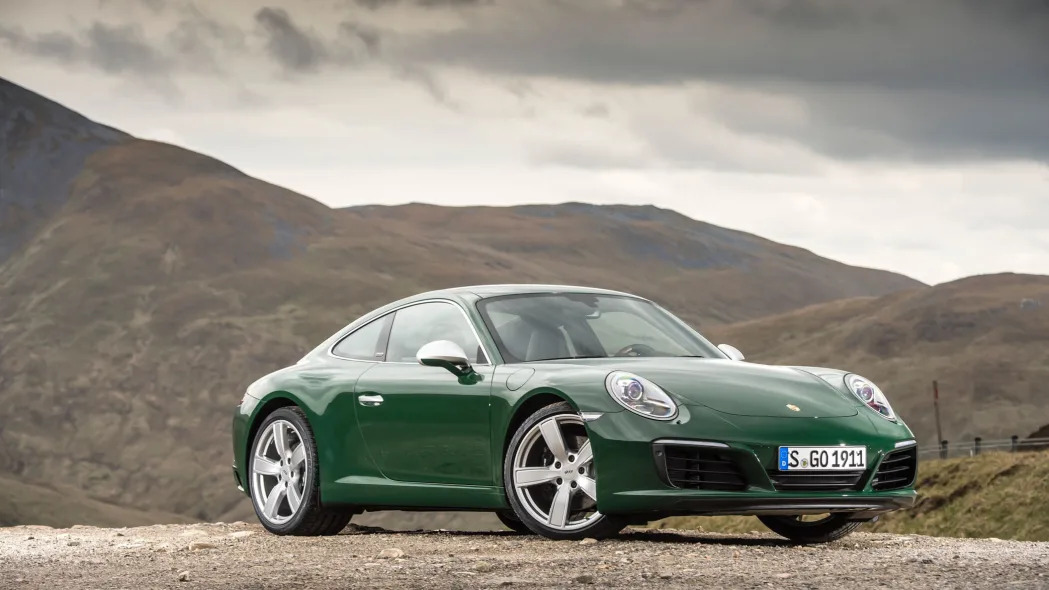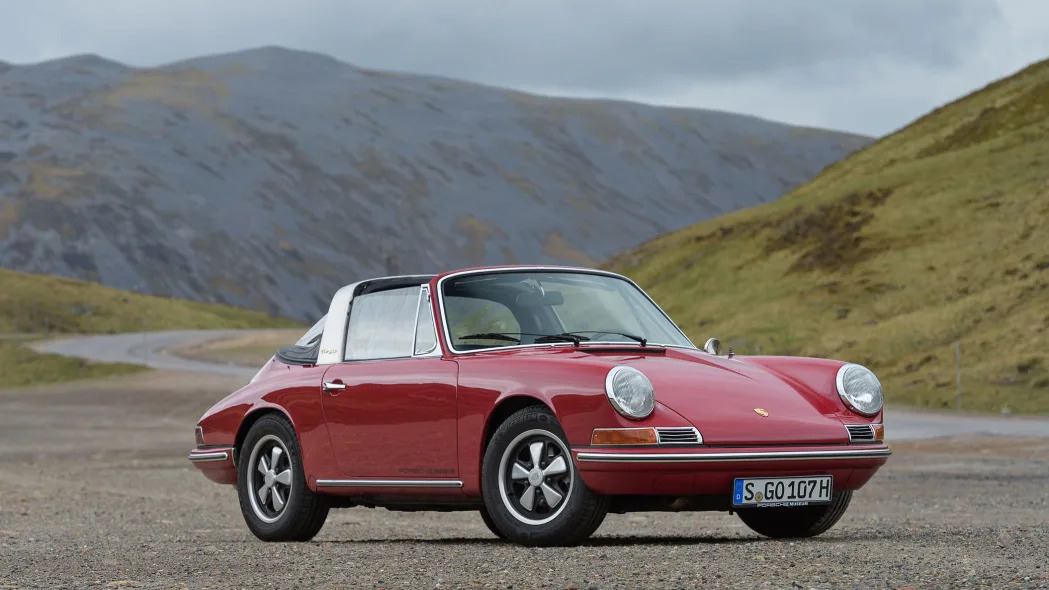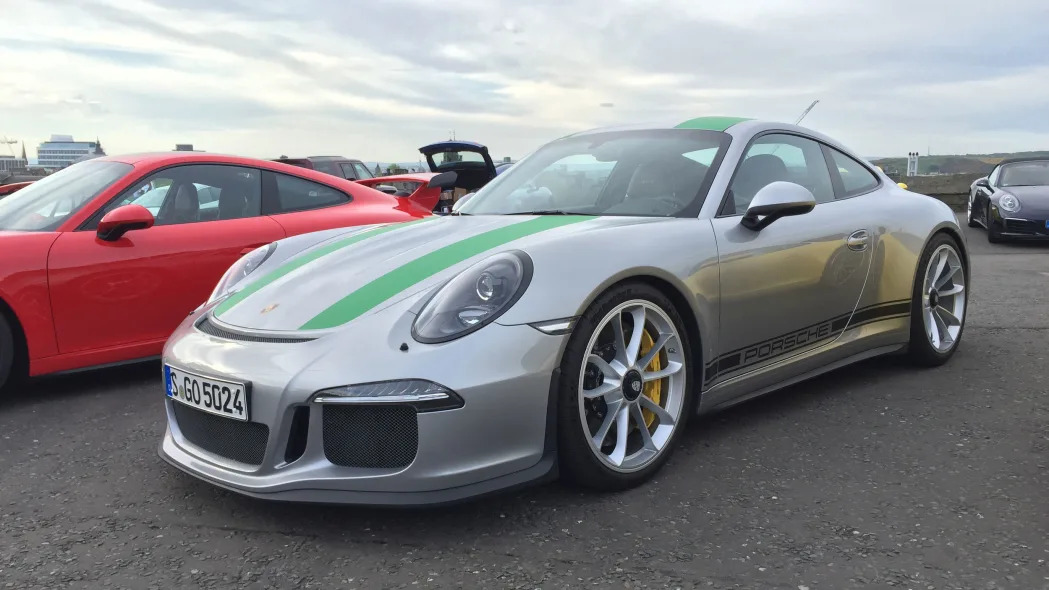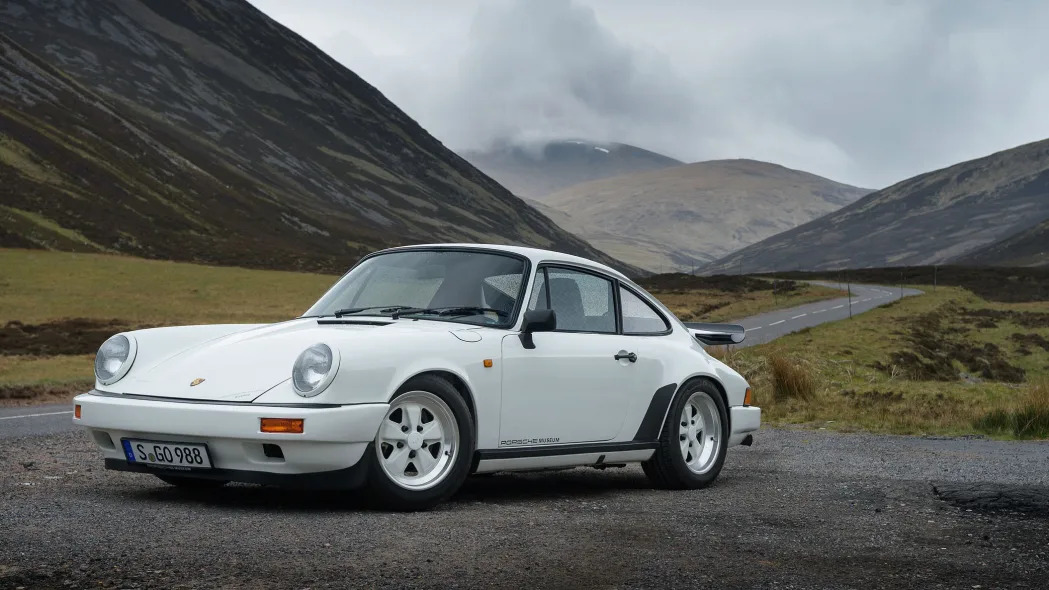If you count a few Porsches badged as 901s before Peugeot threw a fit at the Paris Auto Show and forced the Germans to swap the zero for a one, a million 911s have rolled out of Stuttgart. There was no guarantee at the beginning that the 911 would be a success, the perennial fixture in the sportscar world as we know it today.
It's laughable to think of now, when the 911's the size of a mid-1990s Camry and the base engine is a twin-turbocharged 3.0-liter making a wholesome 365 horsepower, that the 356 crowd got snobby about a little flat-six when it was new. Early critics also dinged it for extra weight. All that's hard to relate to, considering how the 911 is now practically synonymous with the attainable exotic, the safe yet perfectly exhilarating choice of both retiring dentists and Cup racers. And it's still got its engine hanging out behind its transaxle, somehow, despite Porsche's insistence in all other aspects for constant, unbending progress.
And like an early short-wheelbase car in a rough mid-corner adjustment, some bumps along the way nearly whipped the 911's progress around. In the late 1960s, the 914 program was off to a rocky start as Volkswagen and Porsche bickered. The 911 was selling slowly. Things looked rather dire, and so Porsche cooked up the 928, a much more modern car that the company hoped would eventually replace the 911.
It didn't, but it also didn't cure the malaise that afflicted the 911. At certain points, the 911 survived simply because it was the only thing the company built that made any sense, even if it didn't from a corporate perspective. There were some bright spots, but Porsche flirted with disaster until a drastic shake-up in the 1990s saved the company from insolvency and irrelevancy, and also threw out a linchpin of the 911 formula.

The 996-generation 911 had an all-new chassis, the first since the 911's introduction 34 years before. It ditched air-cooling for a blasphemous water-cooling system. And while it was built to a price, immediately noticeable inside, it was a modern 911 built with a modern production philosophy. It set the stage for the real saviors of the 911 that followed soon after: the Cayenne, and to a lesser degree the Boxster. Porsche's SUV, whatever you thought of it, was a winner. The company never looked back, and every 911 since then has improved drastically.
The combination of market volatility, regulatory headwinds, mechanical intransigence, and ill luck should have done the 911 in. Instead, Porsche's brought a host of 911s to Scotland for a triumphal march, with an Irish Green 911 out in front. The millionth 911 built, the culmination of the breed's slow and halting evolution. It's lovely.
I'm airing the 911's dirty laundry, its low points and dynamically problematic layout, because the 911 eventually thrived. In the present, every 911 is brilliant and it's only a matter of picking the flavor you like most. But the 996 was a bold, imperfect break with the past – and it could have gone badly. Once on that course, Porsche steadily perfected the spirit of the 996. The current 991.2 cars might not resemble the original 901 in much except engine layout, but it's fair to say the 991.2 is the best 996 you could imagine.
It's laughable to think of now, when the 911's the size of a mid-1990s Camry and the base engine is a twin-turbocharged 3.0-liter making a wholesome 365 horsepower, that the 356 crowd got snobby about a little flat-six when it was new. Early critics also dinged it for extra weight. All that's hard to relate to, considering how the 911 is now practically synonymous with the attainable exotic, the safe yet perfectly exhilarating choice of both retiring dentists and Cup racers. And it's still got its engine hanging out behind its transaxle, somehow, despite Porsche's insistence in all other aspects for constant, unbending progress.
And like an early short-wheelbase car in a rough mid-corner adjustment, some bumps along the way nearly whipped the 911's progress around. In the late 1960s, the 914 program was off to a rocky start as Volkswagen and Porsche bickered. The 911 was selling slowly. Things looked rather dire, and so Porsche cooked up the 928, a much more modern car that the company hoped would eventually replace the 911.
It didn't, but it also didn't cure the malaise that afflicted the 911. At certain points, the 911 survived simply because it was the only thing the company built that made any sense, even if it didn't from a corporate perspective. There were some bright spots, but Porsche flirted with disaster until a drastic shake-up in the 1990s saved the company from insolvency and irrelevancy, and also threw out a linchpin of the 911 formula.
The 996-generation 911 had an all-new chassis, the first since the 911's introduction 34 years before. It ditched air-cooling for a blasphemous water-cooling system. And while it was built to a price, immediately noticeable inside, it was a modern 911 built with a modern production philosophy. It set the stage for the real saviors of the 911 that followed soon after: the Cayenne, and to a lesser degree the Boxster. Porsche's SUV, whatever you thought of it, was a winner. The company never looked back, and every 911 since then has improved drastically.
The combination of market volatility, regulatory headwinds, mechanical intransigence, and ill luck should have done the 911 in. Instead, Porsche's brought a host of 911s to Scotland for a triumphal march, with an Irish Green 911 out in front. The millionth 911 built, the culmination of the breed's slow and halting evolution. It's lovely.
I'm airing the 911's dirty laundry, its low points and dynamically problematic layout, because the 911 eventually thrived. In the present, every 911 is brilliant and it's only a matter of picking the flavor you like most. But the 996 was a bold, imperfect break with the past – and it could have gone badly. Once on that course, Porsche steadily perfected the spirit of the 996. The current 991.2 cars might not resemble the original 901 in much except engine layout, but it's fair to say the 991.2 is the best 996 you could imagine.
Take the millionth car. It's like a sleeker, exaggerated 996. The front is handsomer, more classic. The interior is improved beyond belief. Compared like trim to like, it's faster and better-handling, and yet also massively more civilized. The rawness has been engineered out, trading some visceral feedback for much greater dynamic competence and at the expense of growth, both in length and width.
And yet a lot has happened in between, and the 991.2's all-around competence actually puts the earlier car's little foibles in a different light. And in the patchwork clouds and sun of Scotland, from the Firth of Forth to the Isle of Skye, we romped in a representative sample of them all. It was a strange scene, but an enlightening one: a dozen cars representing all of the major eras of 911 production, vastly different, and yet all 911s. The Scottish onlookers didn't quite know what to make of it, and for a time neither did I.
There were a few cars arrayed in front of Edinburgh castle the first morning that I was excited to get into: the 1967 911 Targa 2.0, the 1985 911 3.2 Clubsport, and the 1991 964 Turbo. And a few I wasn't, like the 996 GT3, which I assumed would be too aggressive to be much fun on Scotland's weedy little backroads. Figuring out how they related to each other, and to my preconceptions, was going to tell me a lot about where the 911 has been and where it's going.
The revelations came thick and fast. The little early 911, a soft-window Targa that seemed more like a mechanical ladybug than any sort of serious sportscar, for one. Any early 2000s economy car could get the drop on a quick 1960s car, and I've driven early 911s in which the gearbox is a like rowing through a bowl of pudding with a 10-foot stick, except less precise. Expectations were low.
And then, between the buzzy little Targa and clear road ahead, a maddeningly slow car emerged. Taking a glance around, I saw a gap, mashed the odd floor-hinged accelerator, and was considering praying before realizing the Targa was well clear. The low-spec car's 130-horsepower 2.0-liter doesn't sound impressive on paper, but it's a flat-six, and the Targa weighs barely 2,400 pounds. Imagine an early Miata with an extra 400cc, perfectly dialed-in carbs, and a couple extra cylinders. There's no problem keeping up with, or slinging past, modern traffic. And the gearbox is a joy, with long but positive throws and clean engagement.
You sit up high in the Targa, on low-back buckets. It's a relaxed position, and it gives you time to take in the surroundings. With the rear window zipped up but the top off, it's quiet enough inside to chat amid the pleasing scents of hot motor oil, rich mixture, and old leather. And there's a lot of body motion but it's not frenetic. Like a Labrador after a ball, it bounds around, tongue hanging out, pleased as punch to be put to a task. I expected to love it, but not for it to be so engaging, or quick. I could drive it all day, but there are more cars to get into.
And what a contrast to the modern 911 R, too. That's actually what I started the day in. With the number of cars and drivers, there was zero chance of being able to string together a chronological procession, so I went from new to ancient, and then did everything in between. The era-swapping highlighted the deliberateness of the 911 R. Every touchpoint, every control, every sound the thing made (and with a single-mass flywheel and antisocial exhaust, it made a racket), the snick of the shifter – you could ferret out the care and thought that went into making everything feel just so. The 911 R strutted, postured, moved in aggressive little motions like a nervous gangster, but the careful consideration that calibrated each minute aspect of the car's bravado meant nothing felt accidental. To use the trying jargon of our time, it's an expertly curated experience.
The early 911s – the Targa in particular, but also the Carrera 3.2 Clubsport – feel less deliberate. It's as if there was a smaller budget of energy with which to perfect it, so Porsche spent all of it on what was considered outright performance in those innocent days. A German engineer's esoteric hot-rod, if you will. There are raw edges, unusual controls that require nonlinear motions. Inscrutable switchgear appears to have been thrown blindly at the dashboard, rooting wherever it landed. The steering wheel on pre-996 cars is exceptionally close to the upright windshield. There aren't many cars anymore, new Porsches included, which require any acclimation time after hopping inside to figure out how to operate the major controls. Whether it's the heater knobs or what exactly to do when passing around a bumpy, wet corner, the older cars require some forethought.
All of these rare Carrera Clubsports were raw and stripped down, but this one's an early prototype. It's got the characteristic pin-striped seats, which are ludicrously comfortable, but all sorts of unusual touches that didn't carry over to the less-extreme "production" run of several hundred CSs: The three-gauge cluster, and ultra-lightweight bumpers. I heard rumor that it wears exotic, lightweight body panels. The rear seat is, of course, deleted, meaning there's less between me and the lumpy, massaged 3.2-liter flat-six.
I expected it to feel nearly as airy on its feet as the early Targa, except with loads more grip and a ferocious air-cooled bite. Instead, it takes a certain deliberateness to move the thing down the road. The brakes take a shove, with short travel, and the engine's slow to rev compared to, say, the 911 R and its redline-blitzing single-mass flywheel. It's fun and deeply involving, very satisfying to get right, but it thickly underlines the effortlessness of the 991.
As the day progresses, the 911s cut down my expectations time and time again. After an overnight, a second day of driving leads to Knockhill Circuit in Fife, less than an hour north of Edinburgh. There, a few flavors of GT3 are there for us to sample on track, and a GT2 RS for the brave. Knockhill's a technical course for the UK, with lots of elevation, and it's longer than most other tracks over there. That being said, compared to Laguna Seca or Infineon, it's fun but small. The GT3s eat it up and ask for more, while I challenge myself finding second gear with my left hand in the midst of heavy braking and throttle blipping. Then, it's a few minutes of awe as a young race driver tries to scramble my brain with a 911 Cup car. The dynamic extremes of the 911 become vivid on nearly cooked slicks headed up a blind, uphill chicane.
Another American and myself are the last to leave, so we have longer to play with the cars that are left. After the GT3 experience on the track, I snagged the keys to the 996 GT3 and decided to test the most concrete of my prejudices so far. The 996 is as much an albatross as the 911's ever had, anyways. I'd heard rumblings of its uncouthness all day, jackhammering over the rough roads. "The clutch is awful, hard as hell to push," I hear. The day before, two lucky bastards had driven it in a torrential downpour. They had a 50-mile stare going on when they emerged at the hotel, pale-faced and silent. I slid into the fixed-back buckets and glanced at the dash. Might as well have been from an early 1990s Chrysler minivan. Hard plastic, garish shapes. "I'm going to hate this," I told myself.
And then the Mezger engine lit. 3.6 liters, it thrummed and whirred at idle. With more, it yowled. The car writhed underneath me, the wheel danced in my hands. Everything was searingly immediate and completely analog. Sure, it was stiff enough to scramble the GoPro footage I was shooting, and the clutch needed a shove, but it gripped as hard as it bounced me around. Or I enjoyed the punishment – it's hard to tell. It was a bit overwhelming, both because of how well it all worked and how wrong I'd been about it.
As I was trying to think of a way to spirit it out of the country, I saw something disturbing. The millionth 911, in unmistakable Irish Green, was being loaded onto the truck. It was the last car I needed to drive, and had been out on loops the entire day. Everyone wanted their turn in the milestone car, and it looked like I'd missed my chance while falling madly in love with the last car I'd expect. Luckily, Porsche's car wranglers dug deeply into their seemingly bottomless well of patience and got the car unloaded, setting me free on the picturesque roads next to the track.
Fundamentally, the millionth car isn't all that much different than a typical Carrera S you can buy today. Sure, it has some lovely heritage touches: the special badging, the green-illuminated gauges, the houndstooth inserts, and the deep Irish Green paint. But what's important is that it's still powered by a flat-six engine, mounted behind the transaxle, and has that famous profile. The millionth car could have been perfectly normal, without any special touches, and would have a deeper meaning.
After all, the 911's success was not guaranteed. It's persisted, and evolved, in spite of (or because of) a stubborn insistence on engine placement, on seating arrangements, on attitude. Driving this tableau of Porsches, and some I didn't have space to mention here, makes it easy to spot the remarkable breadth of character these cars exude. But driving this green car down the same roads the '67 Targa has bounded down earlier, there's a commonality that defies the objective gulf. I could see the same buyer choosing either a vintage or modern 911; what they'd get would be very different, but the appeal is universal. The 991.2 cars have gained refinement and comfort at the expense of immediacy, but the performance envelope has also increased drastically. And vice versa.
Move the sliders to one direction on the enthusiast scale, and you get the breathtaking 911 R. The other, and you get the lively, charismatic punch of a tiny flat-six. The thing is, you can measure them on the same scale, despite the 911's dance with obsolescence and disaster along the way. The triumph of the 911 is that within the vast spectrum of how the idea's been implemented there's an ingrained character that retains its mystique.
Our minds are hard-wired to impose structure on random events, creating myths to neatly explain chaos. It'd be easy to dismantle the mythos of the continual evolution of the 911, the unbroken lineage between 901 and 991.2, with some arbitrary parameters. But myths usually hide in the hazy mists of several generations back. I've traveled through time and driven a sample of them all, and I can tell you, it's no legend. The 911 is alive and well.
Related Video:







Sign in to post
Please sign in to leave a comment.
Continue